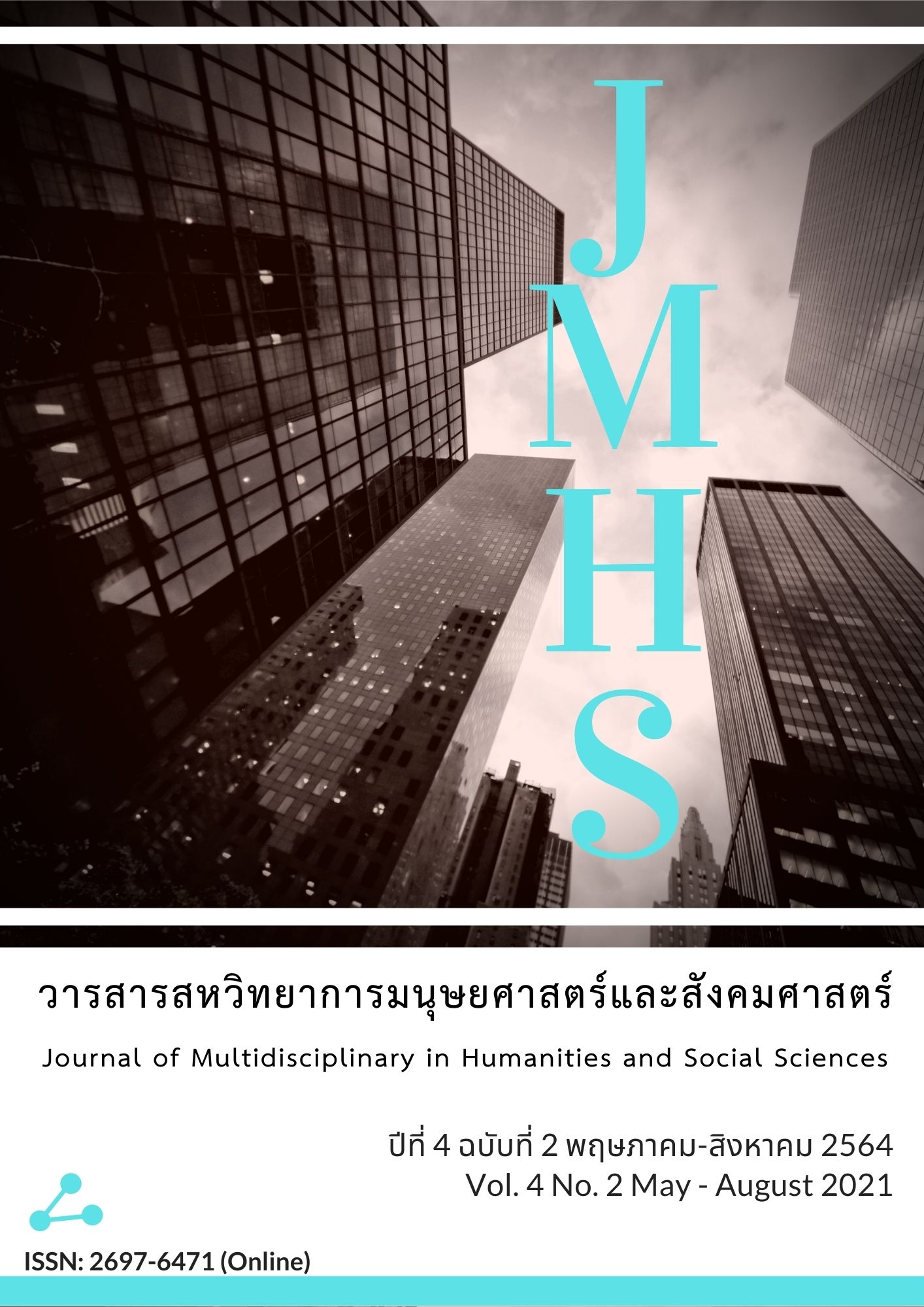The Development of Task-based Integrated Local Learning to enhance English communication ability for Matthayomsuksa Three students
Main Article Content
Abstract
The purposes of this study were as follows: (1) to develop and find the effectiveness of task-based integrated local learning to enhance English communication ability for Matthayomsuksa 3 students; (2) to compare the students’ English communication ability before and after using developed learning steps; and (3) to study students’ satisfaction toward learning. The sample consisted of 36 Matthayomsuksa three students of Kanchananukroh School, Kanchanaburi. They were selected by simple random sampling. The instrument for collecting data was a learning management manual, an English communication ability assessment form, a questionnaire on the opinions of students. Analysis data by percentage, mean, standard deviation, dependent t-test, and Content Analysis. The research results were found as follows:
1. Developed activities of task-based integrated local learning called SESIE learning activity steps was composed of 5 steps: 1) stimulate, 2) explain, 3) study, 4) implement, and 5) evaluate. The effectiveness of the learning activity met the criterion of 87.62/82.33, higher than the required criterion.
2. Students’ communication ability after using the activities was higher than before using, with a statistical significance at the level of 0.01.
3. The students’ satisfaction toward learning activity was at the highest level.
New knowledge gained from this research, it was found that workload-based learning management was found to be a method of teaching and learning that can help develop students' communication skills in English because students learn through practice by themselves. They practice communication skills from classroom simulations through a teacher-organized learning process.
Article Details
Views and opinions appearing in the Journal it is the responsibility of the author of the article, and does not constitute the view and responsibility of the editorial team.
References
กรมวิชาการ. (2545). การวิจัยเพื่อพัฒนาการเรียนรู้ตามหลักสูตรการศึกษาขั้นพื้นฐาน. กรุงเทพฯ: กรมวิชาการ, กระทรวงศึกษาธิการ.
รพีพรรณ สุฐาปัญณกุล. (2557). การพัฒนารูปแบบการสอนภาษาอังกฤษเทคนิค โดยวิธีการสอนที่เน้นภาระงานและโครงงานเพื่อพัฒนาการอ่านภาษาอังกฤษเพื่อความเข้าใจ และความคิด สร้างสรรค์สำหรับนักศึกษาปริญญาตรี(วิทยานิพนธ์ปรัชญาดุษฎีบัณฑิต). มหาวิทยาลัยศิลปากร.
วรรณพรรณ เลิศวัตรกานต์. (2556). การพัฒนาชุดกิจกรรมโดยเน้นงานปฏิบัติเพื่อฝึกทักษะการฟังและพูดภาษาอังกฤษเพื่อการสื่อสาร สำหรับนักเรียนชั้นประถมศึกษาปีที่ 5 โรงเรียนมารีวิทยา(วิทยานิพนธ์ศึกษาศาสตรมหาบัณฑิต). มหาวิทยาลัยศิลปากร.
วไลลักษณ์ พัสดร. (2553). การพัฒนาบทเรียนสำเร็จรูป โดยบูรณาการแหล่งเรียนรู้ เรื่องเศรษฐกิจพอเพียงเคียงคู่เพชรบุรี สำหรับนักเรียนชั้นมัธยมศึกษาปีที่ 2(วิทยานิพนธ์ศึกษาศาสตรมหาบัณฑิต). มหาวิทยาลัยศิลปากร.
ศราธรณ์ หมั่นปรุ และ สุภาวดี ในเสนา. (2562). กลวิธีการสอนอย่างมีประสิทธิภาพเพื่อส่งเสริมการฟัง พูดภาษาอังกฤษของผู้เรียนภาษาอังกฤษเป็นภาษาต่างประเทศ ในศตวรรษที่ 21.วารสารวิชาการเครือข่ายบัณฑิตศึกษามหาวิทยาลัยราชภัฏภาคเหนือ, 9(2), 1-16.
สำนักงานคณะกรรมการการศึกษาขั้นพื้นฐาน. (2552). หลักสูตรแกนกลางการศึกษาขั้นพื้นฐาน พ.ศ. 2551. กรุงเทพฯ: โรงพิมพ์ชุมนุมสหกรณ์การเกษตรแห่งประเทศไทย.
อุษา มะหะหมัด. (2548). การพัฒนาแบบฝึกเสริมทักษะการอ่านเพื่อความเข้าใจ จากนิทานพื้นบ้านไทย สำหรับนักเรียนชั้นประถมศึกษาปีที่ 6 โรงเรียนวัดโพธิ์ จังหวัดนครปฐม(วิทยานิพนธ์ศึกษาศาสตรมหาบัณฑิต). มหาวิทยาศิลปากร.
Littlewood, W. (1983). Communicative Language Teaching: An Introduction. Cambridge: Cambridge University.
Morrow, K. (1981). Principle of Communicative and Methodology. London: Longman.


